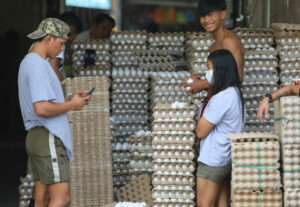




Quarterly Economic Growth Release: More BSP cuts to come
 DOWNLOAD
DOWNLOAD

Monthly Economic Update: Fed catches up
 DOWNLOAD
DOWNLOAD

Inflation Update: Steady and mellow
 DOWNLOAD
DOWNLOAD


Risks mount for Philippines after best growth in half a century

The Philippines just notched its fastest economic growth since disco music was rattling the airwaves and Gerald Ford was US president. Sustaining that pace against a gloomy global backdrop will be a challenge.
The economy grew 7.6% in 2022, data showed Thursday, its best performance since 1976. President Ferdinand Marcos Jr. is betting the country can keep on expanding near 7% this year.
Yet dark economic clouds loom across the globe, adding to the 14-year-high inflation and other domestic pressures, that could keep the growth rate fragile.
Here are some of the factors to watch out for in the Philippines:
CONSUMPTION
A closer look at the data shows personal consumption grew 7% year-on-year in the three months to December, the slowest pace since a contraction in the first quarter of 2021 when the nation hadn’t fully reopened. That suggests that fast inflation and the central bank’s most aggressive rate tightening in two decades are beginning to clip growth.
The “initial boost from pent-up demand will start to fade in the coming quarters,” said Oxford Economics Ltd.’s Makoto Tsuchiya. “Elevated inflation will continue to strain real purchasing power.”
RISING COSTS
The Philippines is still grappling with soaring food prices that crimp day-to-day budgets. Costs of onions and sugar have spiked in the past months.
The policy tightening to rein in that price growth — 350 basis points and counting — would continue to bring pain and spending restraint to other parts of the economy this year. The key rate at 5.5% is the highest since 2008.
EXPORTS
The reopening of the world’s No. 2 economy is set to provide a boost especially to its neighbors, with the Philippines among those ready to welcome back Chinese travelers.
As the region’s biggest trading partner, China also is expected to breathe more life into Southeast Asian economies that have seen slower factory demand and sentiment. Philippine exports contracted in December.
But beyond China, the global growth picture is dim. The International Monetary Fund, among others, warns of recession sweeping the globe this year and a downturn remains a hot debate in the US.
REMITTANCES
Typically resilient during crises, money sent home to the Philippines from abroad will have to stay healthy this year to keep fueling consumption. While the central bank expects cash remittances to increase 4% this year, slowing economic growth in some countries remains a key risk to labor demand.
Still, funds from overseas Filipinos, along with a booming outsourcing industry and government infrastructure, are “important economic bright spots” for 2023, said Michael Ricafort, economist at Rizal Commercial Banking Corp.
A commitment to enhance governance, strengthen regulation and transparency will be key to boosting sentiment, Arsenio Balisacan, the head of the National Economic and Development Authority, said on Thursday. — Bloomberg
This article originally appeared on bworldonline.com





 By BusinessWorld
By BusinessWorld